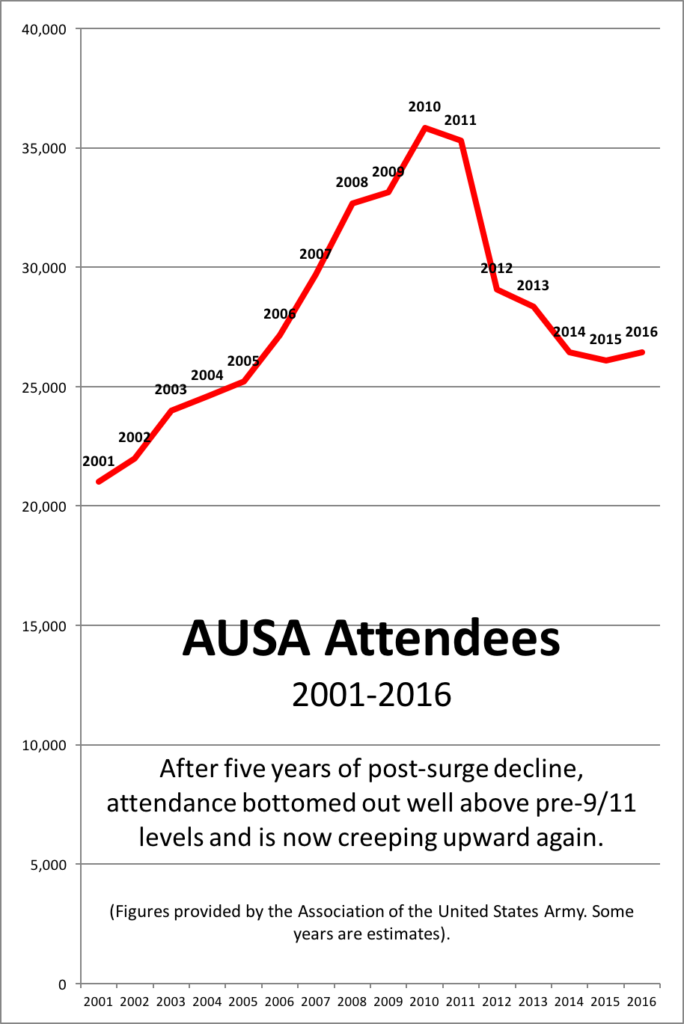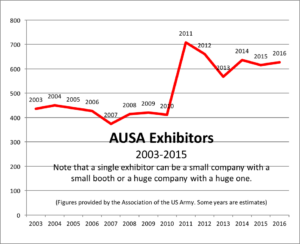
WASHINGTON: DC’s biggest defense conference just stopped getting smaller. The Association of the US Army’s annual meeting is a cultural touchstone for the largest service and a leading indicator for the health of the defense industry. Like the Pentagon budget, AUSA attendance peaked during the troop surge in 2010, then shrank rapidly with the drawdowns, cutbacks, and sequestration that followed. But this October, for the first time in six years, attendance went up.
 Looking at figures for the last 16 years, provided to Breaking Defense by AUSA, a clear pattern emerges. The post-surge decline has not outright reversed: This year’s 26,427 attendees is still 35 percent below the 2010 peak. But the decline has leveled out over the last three years. 2016’s number is almost identical to 2014’s. Even if this year’s uptick is a fluke, AUSA attendance has at least stabilized — and it’s stabilized at a figure 26 percent above the conference’s size in 2001. That suggests significant and sustainable growth has occurred since 9/11, not just in the AUSA conference but in the defense industry it represents.
Looking at figures for the last 16 years, provided to Breaking Defense by AUSA, a clear pattern emerges. The post-surge decline has not outright reversed: This year’s 26,427 attendees is still 35 percent below the 2010 peak. But the decline has leveled out over the last three years. 2016’s number is almost identical to 2014’s. Even if this year’s uptick is a fluke, AUSA attendance has at least stabilized — and it’s stabilized at a figure 26 percent above the conference’s size in 2001. That suggests significant and sustainable growth has occurred since 9/11, not just in the AUSA conference but in the defense industry it represents.
 Some of the conference’s growth may have more to do with AUSA’s strategic choices than with the state of the defense industry as a whole. This year marked the debut of the association’s first new president in 18 years, with legendary Gen. Gordon Sullivan giving the reins to Gen. Carter Ham. (Click here for our video interview with Gen. Ham).
Some of the conference’s growth may have more to do with AUSA’s strategic choices than with the state of the defense industry as a whole. This year marked the debut of the association’s first new president in 18 years, with legendary Gen. Gordon Sullivan giving the reins to Gen. Carter Ham. (Click here for our video interview with Gen. Ham).
AUSA has also invigorated its conference program beyond the annual meeting. In 2014, it launched a series of successful one-day events on focused subjects — such as aviation, missile defense, or networks — held in-house at its new conference center in Arlington; in a fluke of scheduling, there are two of these “Hot Topics” this week alone, on ground combat and cyber warfare, Also in 2014, AUSA’s winter conference moved from Florida to Huntsville, Ala. — home of Army Materiel Command — to reduce costs in and has been chugging along steadily since at about 6,000 attendees.
Overall, however, no amount of clever marketing by AUSA could cancel out the general decline in the defense industry. That AUSA’s events are doing well is a good sign the industry is too.
‘Poisoned’ data could wreck AIs in wartime, warns Army software acquisition chief
“Any commercial LLM that is out there, that is learning from the internet, is poisoned today,” Jennifer Swanson said, “but our main concern [is] those algorithms that are going to be informing battlefield decisions.”


























